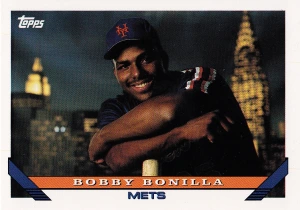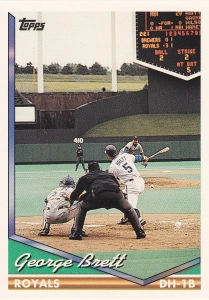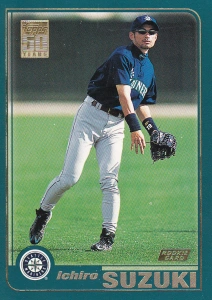All-Star Games: NL won 6 times, AL won 4 times (Gary Carter won 2 AS-game MVPs in the 1980’s)
 World Series: The Dodgers (2) were the only team with multiple World Championships in the 80’s. The Cardinals went to 3 World Series, while the Phillies, Royals and Athletics also went to multiple series.
World Series: The Dodgers (2) were the only team with multiple World Championships in the 80’s. The Cardinals went to 3 World Series, while the Phillies, Royals and Athletics also went to multiple series.
1980: Philadelphia Phillies over Kansas City Royals, 4-2
1981: Los Angeles Dodgers over New York Yankees, 4-2
1982: St. Louis Cardinals over Milwaukee Brewers, 4-3
1983: Baltimore Orioles over Phillies, 4-1
1984: Detroit Tigers over San Diego Padres, 4-1
1985: Royals over Cardinals, 4-3
1986: New York Mets over Boston Red Sox, 4-3
1987: Minnesota Twins over Cardinals, 4-3
1988: Dodgers over Oakland Athletics, 4-1
1989: Athletics over San Francisco Giants, 4-0
**********
Multiple MVP: AL – Robin Yount, SS & OF, Brewers (1982, 1989)
NL – Mike Schmidt, 3B, Phillies (1980-1981, 1986)
Dale Murphy, OF, Atlanta Braves (1982-1983)
 Multiple Cy Young: AL – Roger Clemens, SP, Red Sox (1986-1987)
Multiple Cy Young: AL – Roger Clemens, SP, Red Sox (1986-1987)
Brett Saberhagen, SP, Royals (1985, 1989)
NL – Steve Carlton, SP, Phillies (1980, 1982)
Other Multiple Award Winners: AL – Cal Ripken, SS, Orioles (ROY – 1982, MVP – 1983)
Clemens (CY, MVP – 1986, CY 1987)
Jose Canseco, OF, Athletics (ROY – 1986, MVP – 1988)
Willie Hernandez, RP, Tigers (CY, MVP – 1984)
NL – Fernando Valenzuela, SP, Dodgers (ROY, CY – 1981)
Dwight Gooden, SP, Mets (ROY – 1984, CY – 1985)
Rollie Fingers, RP, Brewers (CY, MVP – 1981)
**********
 MLB Amateur Draft – notable selections:
MLB Amateur Draft – notable selections:
Darryl Strawberry was the first pick of the decade.
There were quite a few guys who were better known for another sport – John Elway (’81), Deion Sanders (’85), Bo Jackson (’86).
Tony Gwynn (’81) and Craig Biggio (’87) both had careers with 3,000 hits.
Roger Clemens (’83), Greg Maddux (’84), Tom Glavine (’84) and Randy Johnson (’85) all had careers with over 300 wins.
Mark McGwire (’84), Barry Bonds (’85), Rafael Palmeiro (’85), Gary Sheffield (’86), Ken Griffey Jr. (’87), Frank Thomas and Jim Thome (both ’89) all hit 500 career home runs.
Other notable draftees include Doc Gooden (’82), Barry Larkin (’85), John Smoltz (’85), Mike Piazza (in the 62nd round of ’88), Jeff Bagwell and Jeff Kent (both in ’89).
**********
Hall of Fame:
(’80) A. Kaline, D. Snider, C. Klein, T. Yawkey, (’81) B. Gibson, J. Mize, R. Foster, (’82) H. Aaron, F. Robinson, T. Jackson, H. Chandler, (’83) B. Robinson, J. Marichal, G. Kell, W. Alston, (’84) H. Killebrew, L. Aparicio, D. Drysdale, P.W. Reese, R. Ferrell, (’85) L. Brock, H. Wilhelm, E. Slaughter, A. Vaughan, (’86) W. McCovey, E. Lombardi, B. Doerr, (’87) C. Hunter, B. Williams, R. Dandridge, (’88) W. Stargell, (’89) J. Bench, C. Yastrzemski, R. Schoendienst, A. Barlick

This list includes the all-time home run and stolen bases leaders at the time, 4 players with 3,000 hits, 1 pitchers with 3,000 strikeouts, 4 players with 500 home runs, 2 Negro League players, a commissioner of MLB, a team owner, and an umpire.
**********
Batting Leaders – best season, overall decade leader, most times leading league:
Avg. (season) George Brett 1980 KCR .390, (decade) Wade Boggs BOS .352
Boggs won 5 AL batting titles, Tony Gwynn won 4 NL batting titles
HR (season) Andre Dawson 1987 CHC / Mark McGwire 1987 OAK 49, (decade) Schmidt PHI 313
Schmidt led the NL 5x, Tony Armas & Reggie Jackson each led the AL 2x
RBI (season) Don Mattingly 1985 NYY 145, (decade) Eddie Murray BAL-LAD 996
Schmidt led the NL 4x, Cecil Cooper led the AL 2x
 R (season) Rickey Henderson 1985 NYY 146, (decade) Henderson OAK-NYY 1,122
R (season) Rickey Henderson 1985 NYY 146, (decade) Henderson OAK-NYY 1,122
Tim Raines & Ryne Sandberg each led the NL 2x, Henderson led the AL 4x
SB (season) Henderson OAK 130 – MLB record, (decade) Henderson OAK-NYY 838
Henderson led the AL 9x, Vince Coleman led the NL 5x
H (season) Boggs 1985 BOS 240, (decade) Robin Yount MIL 1,731
Kirby Puckett led the AL 3x, Gwynn led the NL 4x
Pitching Leaders:
W (season) Steve Stone 1980 BAL 25, (decade) Jack Morris DET 162
Roger Clemens and LaMarr Hoyt each led the AL 2x, Steve Carlton led the NL 2x
K (season) Mike Scott 1986 HOU 306, (decade) Nolan Ryan HOU-TEX 2,167
Mark Langston led the AL 3x, Steve Carlton led the NL 3x
Ryan led the NL 2x and the AL 1x
ERA (season) Dwight Gooden NYM 1.53, (decade) Gooden NYM 2.64
Ryan won 2 NL ERA titles, no pitcher won multiple AL ERA titles
SV (season) Dave Righetti 1986 NYY 46 – MLB Record, (decade) Jeff Reardon NYM-MON-MIN 264
Dan Quisenberry led the AL 5x, Bruce Sutter led the NL 4x
**********
My All-Decade team:
C – Gary Carter, MTL-NYM (.264/207/800)
1B – Murray, BAL-LAD (.293/274/996)
2B – Sandberg, PHI-CHC (.289/14/61, MVP)
3B – Schmidt, PHI (.277/313/929, 3 MVPs)
SS – Ripken, BAL (.276/204/744, ROY, MVP)
OF – Henderson, OAK-NYY (.291/137/535, 838 SB, 1,122 R)
OF – Yount, MIL (.304/174/821, 337 2B, 2 MVPs)
 OF – Murphy, ATL (.273/308/929, 2 MVPs)
OF – Murphy, ATL (.273/308/929, 2 MVPs)
DH – Boggs, BOS (.352/64/523, .443 OBP)
SP – Ryan, HOU-TEX (122-104/3.14/2,167)
SP – Gooden, NYM (100-39/2.64/1,168, CY)
SP – Clemens, BOS (95-45/3.06/1,215, 2 CY, MVP)
RP – Dan Quisenberry, KCR-STL (53-43/2.67/364, 239 SV)
The left side of the infield was the best part of the diamond, and third base was the most stacked position out there. This is one thing notable about the 1980’s – 3 of the best 5 third baseman in history played the primary portion of their career in the 1980’s. With all respect to Boggs and Brett, Schmidt is the best 5-man of all-time and was the best in this particular decade, too. In fact, he’d be right up there for my pick for player of the decade – he did in fact win the award from The Sporting News. Boggs was really close, though, so I cheated and added him as the designated hitter.
I said right up there for Schmidt – I’d have to give player of the decade to Rickey Henderson. He was on base more than any other player in the decade, he’s the only player who scored over 1,000 runs (his 1,000+ were 150 more than the 2nd best player) he set the single season stolen base record and almost set the career stolen base record in the decade. He’s my first outfielder. Robin Yount was there with Boggs, just behind Schmidt and Henderson as the best players of the decade – I decided I had a choice to put him at short or center field, since he won an MVP at both positions. I put him in the Outfield as I wanted to get either Ripken or Trammell in at Shortstop. This was actually a closer call than I thought. Trammell’s WAR is a little higher than Cal, and their offensive numbers are very similar. A big reason for this is because Cal didn’t play the first 2 years of the decade. Plus he won a ROY and an MVP (Trammell did have a runner-up in MVP voting), so I went with the Iron Man. Ozzie Smith was also very good at shortstop, but not quite as good as those guys. I went with Murphy for the 3rd outfield spot, though Tim Raines and Andre Dawson belong in that argument. Eddie Murray and Gary Carter were clear-cut at First and Catcher. At second, Lou Whitaker was around the whole decade but Sandberg was better for the 8 full years he played, and he won that MVP.
Selecting the pitchers were a tough decision. Ryan was just too good for the whole decade to keep out, but it came down to what I wanted to do with Clemens and Gooden – who were fairly indistinguishable between each other, so I would either pick both or neither. They were clearly the best two pitchers in the last 5 or 6 years of the 80’s, but should I give credit to guys who pitched the whole season? I chose to go with both of them, as they were truly great for most of the decade. Dave Stieb and Fernando Valenzuela were close, while Saberhagen, Hershiser and Carlton was similar to Clemens and Gooden – very good but only played in part of the decade (though Carlton was in the early part of the decade). Quisenberry was an easy choice for best reliever – though he didn’t do much in the last few years of the decade, he was the best by a significant margin in the first 6 years.





















































